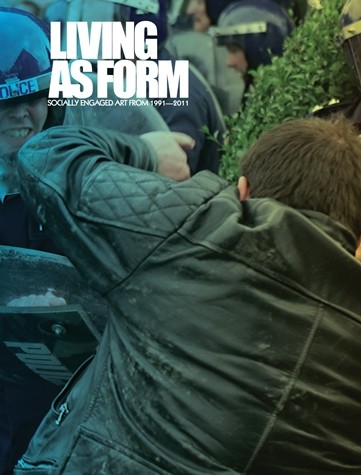Nato Thompson (ed.): Living as Form: Socially Engaged Art from 1991-2011 (2012)
Filed under book, catalogue | Tags: · activism, art, participation, performance, public art, public sphere, social movements

“Over the past twenty years, an abundance of art forms have emerged that use aesthetics to affect social dynamics. These works are often produced by collectives or come out of a community context; they emphasize participation, dialogue, and action, and appear in situations ranging from theater to activism to urban planning to visual art to health care. Engaged with the texture of living, these art works often blur the line between art and life. This book offers the first global portrait of a complex and exciting mode of cultural production—one that has virtually redefined contemporary art practice.
Living as Form grew out of a major exhibition at Creative Time in New York City. Like the exhibition, the book is a landmark survey of more than 100 projects selected by a thirty-person curatorial advisory team; each project is documented by a selection of color images. The artists include the Danish collective Superflex, who empower communities to challenge corporate interest; Turner Prize nominee Jeremy Deller, creator of socially and politically charged performance works; Women on Waves, who provide abortion services and information to women in regions where the procedure is illegal; and Santiágo Cirugeda, an architect who builds temporary structures to solve housing problems.
Living as Form contains commissioned essays from noted critics and theorists who look at this phenomenon from a global perspective and broaden the range of what constitutes this form.”
Contributing authors: Claire Bishop, Carol Becker, Teddy Cruz, Brian Holmes, Shannon Jackson, Maria Lind, Anne Pasternak, Nato Thompson.
Publisher Creative Time, New York, and MIT Press, 2012
ISBN 9780262017343, 0262017342
259 pages
Reviews: Tom Snow (review31, n.d.), Wendy Vogel (Brooklyn Rail, 2012), Jennie Klein (PAJ, 2015), Kim Yasuda (Public Art Dialogue, 2013), Régine Debatty (We Make Money Not Art, 2012), Mark Gardner (Urban Design Review, 2012), Michael DiRisio (Public Journal, 2014), Danielle Child (Reviews in Culture, 2012), Andreas Hudelist (Theater Forschung, 2014).
Exh. reviews: Jens Hoffmann (Frieze, 2012), Ben Davis (International Socialist Review, 2012), Rachel Daniell (emisferica, 2012).
Project website, incl. Social Practice archive (300+ projects)
Exhibition
Publisher
WorldCat
PDF (19 MB)
Internet Archive (added on 2023-7-7)
Katalin Cseh-Varga, Adam Czirak (eds.): Performance Art in the Second Public Sphere: Event-Based Art in Late Socialist Europe (2018)
Filed under book | Tags: · art history, body art, communism, east-central europe, eastern europe, happening, performance, performance art, public sphere, socialist realism, southeastern europe, theatre, underground

“Performance Art in the Second Public Sphere is the first interdisciplinary analysis of performance art in East, Central and Southeast Europe under socialist rule. By investigating the specifics of event-based art forms in these regions, each chapter explores the particular, critical roles that this work assumed under censorial circumstances.
The artistic networks of Yugoslavia, Hungary, Latvia, Lithuania, Poland, Romania, East Germany and Czechoslovakia are discussed with a particular focus on the discourses that shaped artistic practice at the time, drawing on the methods of Performance Studies and Media Studies as well as more familiar reference points from art history and area studies.”
Contributors: Roddy Hunter, Miško Šuvaković, Dietmar Unterkofler, Ileana Pintilie, Cristian Nae, Andrej Mirčev, Andrea Bátorová, Berenika Szymanski-Düll, Kata Krasznahorkai, Laine Kristberga, Adam Czirak, Amy Bryzgel, Jasmina Tumbas, Beáta Hock, Angelika Richter, Maja Fowkes and Reuben Fowkes.
Publisher Routledge, London, 2018
ISBN 9781138723276, 1138723274
xii+263 pages
Project website
Publisher
WorldCat
Megan Driscoll: Art on the Internet and the Digital Public Sphere, 1994-2003 (2018)
Filed under book | Tags: · art history, internet, internet art, net art, networks, public sphere, web
“This dissertation narrates the development of internet art, a diverse set of practices united by their interrogation of the technological, social, and/or political bases of computer networks. Covering the period from 1994, when internet art coalesced around the rise of the World Wide Web, to 2003, when both internet art and internet culture writ large began to respond to the rise of social media and web 2.0 technologies, the dissertation homes in on specific net art projects that variously engaged or challenged this period’s most persistent claim: that the internet is a new, digital public sphere. By studying how these artworks critiqued this claim, the dissertation uncovers three major models through which net art has asserted the publicness of computer networks—as an interpersonal network that connects or unites strangers into groups; as a virtual space akin to physical spaces of public gathering, discourse, and visibility; and as a unique platform for public speech, a new mass media potentially accessible to all.
Claims for the public status of computer networks rest on their ability to circulate information and facilitate discussion and debate. This definition of publicness is rooted in the concept of the classical public sphere as theorized by J�rgen Habermas. The dissertation thus reviews Habermas’s model of the classical public sphere, and its most significant critiques, in order to interrogate the terms of a digital public sphere. The dissertation also engages Michael Warner’s work on the formation of publics, counterpublics, and the mass-cultural public sphere; Oskar Negt and Alexander Kluge’s analysis of shared experience as the foundation of the formation of public spheres and the role of mass media in this process; Henri Lefebvre’s articulation of the social production of space; and Gilles Deleuze and Alexander Galloway’s respective analyses of the role of network logics in systems of control.
As a whole, the dissertation provides an historical account and critical analysis of internet art that encompasses not only its technological evolution but also its confrontation with the claims of publicness upon which our understanding of computer networks, and the art made on and about them, are founded.”
PhD Dissertation
Publisher University of California, Los Angeles, 2018
349 pages
via Cornelia

